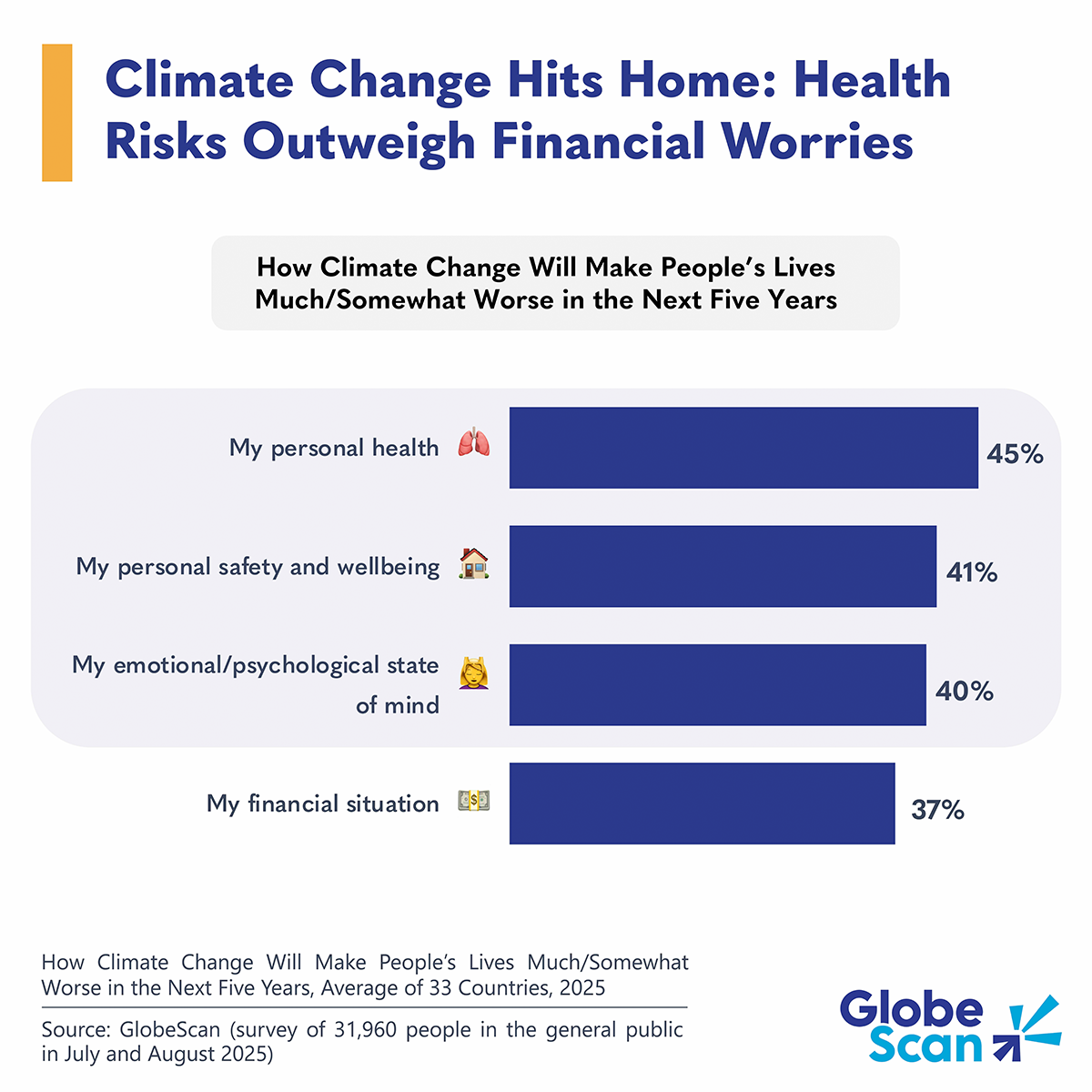45 percent of people think climate change will harm their health – Trellis Group

Report on Public Perception of Climate Change Impacts and Alignment with Sustainable Development Goals
Executive Summary
A recent global survey indicates that personal health is the foremost concern among the public regarding the impacts of climate change. This finding presents a significant opportunity to frame climate initiatives within the context of the Sustainable Development Goals (SDGs), particularly SDG 3 (Good Health and Well-being), to drive broader public engagement and action. The data reveals that anxieties about health, safety, and psychological well-being surpass financial concerns, suggesting that a human-centric approach is critical for mobilizing support for SDG 13 (Climate Action).
Key Survey Findings
Data from a survey of nearly 32,000 people across 33 countries highlights public apprehension about the personal consequences of climate change over the next five years. The primary concerns are categorized as follows:
- Health Impacts: 45% of respondents believe climate change will negatively affect their personal health.
- Safety and Well-being: 41% of respondents expect climate change to worsen their personal safety and well-being.
- Psychological State: 40% of respondents foresee a decline in their emotional and psychological state.
- Financial Vulnerability: 37% of respondents believe their financial situation will deteriorate due to climate change.
Analysis and Linkage to Sustainable Development Goals (SDGs)
The survey results establish a clear connection between public concerns and the core objectives of the 2030 Agenda for Sustainable Development. The data can be analyzed through the lens of the following SDGs:
- SDG 3: Good Health and Well-being: The finding that health is the primary concern directly aligns with SDG 3. This provides a powerful mandate to position climate action as a public health imperative, emphasizing benefits such as improved air quality, secure access to safe water, and reduced risk of climate-related diseases.
- SDG 13: Climate Action: By understanding that health is a universal motivator, strategies to advance SDG 13 can be made more effective. Communicating the immediate health co-benefits of climate policies can translate abstract environmental threats into tangible, personal incentives for supporting climate action.
- SDG 11: Sustainable Cities and Communities: The 41% of respondents concerned about personal safety and well-being reflects the objectives of SDG 11, which aims to make human settlements inclusive, safe, resilient, and sustainable in the face of climate-related disasters.
- SDG 1 (No Poverty) and SDG 8 (Decent Work and Economic Growth): The concern over financial deterioration (37%) links climate change to economic stability. This highlights the threat that climate impacts pose to poverty reduction efforts and the goal of achieving sustainable economic growth for all.
Conclusion and Strategic Implications
The report concludes that public health is the most potent personal link to climate change. To accelerate progress on the Sustainable Development Goals, climate change communication and policy-making should prioritize the immediate human health and well-being dimensions. Framing climate action as a direct investment in achieving SDG 3 can build a broader, more resilient coalition of support, engaging audiences beyond traditional environmental circles and fostering widespread backing for the integrated goals of the 2030 Agenda.
Methodology Note
The findings are based on data from GlobeScan’s Societal Shift project, which surveyed nearly 32,000 individuals in 33 countries during July and August 2025.
Analysis of SDGs in the Article
-
Which SDGs are addressed or connected to the issues highlighted in the article?
The article primarily addresses two Sustainable Development Goals (SDGs):
- SDG 3: Good Health and Well-being: This is the central theme of the article. It explicitly discusses how people are most concerned about the negative effects of climate change on their “personal health,” “emotional and psychological state,” and overall “well-being.” The text suggests framing climate change as a “public health issue” to motivate action.
- SDG 13: Climate Action: The entire context of the article is “climate change” and how to drive “climate action.” It analyzes public perception of climate risks and proposes using health concerns as a “rallying point for climate action” to make the issue more “relatable and widely supported.”
-
What specific targets under those SDGs can be identified based on the article’s content?
Based on the article’s focus, the following specific targets can be identified:
- Target 3.4: By 2030, reduce by one third premature mortality from non-communicable diseases through prevention and treatment and promote mental health and well-being. The article directly connects to this target by highlighting that “40 percent foresee a decline in their emotional and psychological state,” addressing the promotion of mental health and well-being.
- Target 3.9: By 2030, substantially reduce the number of deaths and illnesses from hazardous chemicals and air, water and soil pollution and contamination. The article implies this target by suggesting that framing climate action around tangible benefits like “cleaner air, safer water and reduced risk of disease” can motivate the public. These benefits are the core objectives of Target 3.9.
- Target 13.3: Improve education, awareness-raising and human and institutional capacity on climate change mitigation, adaptation, impact reduction and early warning. The article is fundamentally about public awareness and perception. The GlobeScan survey data it presents is a measure of this awareness. The article’s conclusion that health concerns can “engage people beyond traditional environmental audiences” is a strategy for improving awareness and capacity for climate action, which is the goal of this target.
-
Are there any indicators mentioned or implied in the article that can be used to measure progress towards the identified targets?
Yes, the article provides specific quantitative data from the GlobeScan survey that can serve as indicators:
- Indicator for Target 13.3: The survey results themselves act as direct indicators of public awareness regarding climate change impacts. Specific data points include:
- The “45 percent of people [who] believe climate change will negatively affect their personal health.”
- The “41 percent [who] expect climate change to worsen their personal safety and well-being.”
These percentages measure the level of public awareness and concern, which is a key component of Target 13.3.
- Indicator for Target 3.4: The finding that “40 percent foresee a decline in their emotional and psychological state” serves as a direct indicator of the perceived impact of climate change on mental health, which is a component of this target.
- Indicator for Target 3.9: While the article does not mention official indicators like mortality rates from pollution, it implies a proxy indicator. The “45 percent of people [who] believe climate change will negatively affect their personal health” can be interpreted as an indicator of public concern about the risks of illnesses from environmental factors like poor air and water quality, which this target aims to reduce.
- Indicator for Target 13.3: The survey results themselves act as direct indicators of public awareness regarding climate change impacts. Specific data points include:
-
Create a table with three columns titled ‘SDGs, Targets and Indicators” to present the findings from analyzing the article.
SDGs Targets Indicators SDG 3: Good Health and Well-being Target 3.4: Promote mental health and well-being. The percentage of people who “foresee a decline in their emotional and psychological state” due to climate change (40%). SDG 3: Good Health and Well-being Target 3.9: Substantially reduce the number of deaths and illnesses from pollution and contamination. The percentage of people who “believe climate change will negatively affect their personal health” (45%), implying concern over risks from “cleaner air, safer water and reduced risk of disease.” SDG 13: Climate Action Target 13.3: Improve education, awareness-raising and human and institutional capacity on climate change. Survey data measuring public awareness of climate change impacts, such as the percentage of people concerned about effects on personal health (45%) and personal safety (41%).
Source: trellis.net
What is Your Reaction?
 Like
0
Like
0
 Dislike
0
Dislike
0
 Love
0
Love
0
 Funny
0
Funny
0
 Angry
0
Angry
0
 Sad
0
Sad
0
 Wow
0
Wow
0
















































/environment-climate-change-and-health-(ech)/water-sanitation-hygiene-and-health-(wsh)/landfill-tuvalu-36092.tmb-1200v.jpg?sfvrsn=5c21fe40_1#)

.jpg.webp?itok=0ZsAnae9#)

























